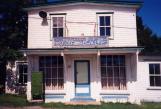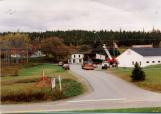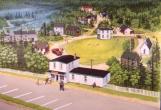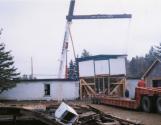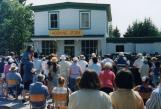1
Saving the Store and its RecordsIn 1975 Mildred and Garth Hosking decided to close the Hosking General Store. It was no longer a viable business. The allure of a newly built supermarket, just up the road in Jeddore, helped make closing easier.
The building remained in service to the community. It was used as a meeting place for the Board of Trade, and it was rented for some time to the IOOF (Independent Order of Odd Fellows).
By the 1994s, the store was a hundred years old, and starting to show its age. It fell into disrepair and became a liability. Demolition was imminent.
3
The demise of the Hosking Store was not unique. In the surrounding communities, buildings of a similar age and landmark significance were falling into irreversible disrepair.In 1994 local residents began to talk about a way of rescuing these buildings and turning them into a living history museum. A heritage society was formed, and funding options were pursued.
The Hosking family approached the infant society, and offered the building to them. Soon the impossible began to happen.
5
With mostly volunteer labour and donated equipment, the upper storey of the store was lifted off and transported on a flatbed truck to a storage area. The ground floor was cut into pieces, stacked, and labeled for future reassembly.7
It took five years for the Lake Charlotte Area Heritage Society to secure enough funds to create a thirteen-building "village" representing a typical 1940s Eastern Shore coastal community.Hundreds of thousands of dollars were raised by the community in donations of money and labour. All three levels of government committed funds.
9
Through the spring and early summer of 2000, volunteers and hired help worked quickly to move and restore buidlings as they would have been in the 1940s.Ten buildings were rescued from the community: The Hosking General Store; the Little Harbour Schoolhouse; the Clam Harbour United Church; the Ervin Webber Homestead, barn, and ice house; the Norm Hutt Boatshop; the Ford Webber Workshop; the Upper Lakeville Community Hall; and the Upper Lakeville butcher shop (converted to a garage). A replica gold prospecting complex, fish store, and cookhouse were built from new and used materials. Each building was restored with artifacts from the area and all were researched to ensure their authentic representationof the Eastern Shore during the 1940s.
11
The ground floor portion of the store had substantial repairs made to it.2000
Lake Charlotte, Nova Scotia
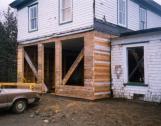
13
The Hosking Store is now the entrance to Memory Lane Heritage Village, a living history museum that allows visitors to explore the sights, sounds and smells of the 1940s.14
A binder used by Mrs. J.D. Mitchell in 1900 to store her invoices and other business papers.April, 2003
Oyster Pond, Nova Scotia

